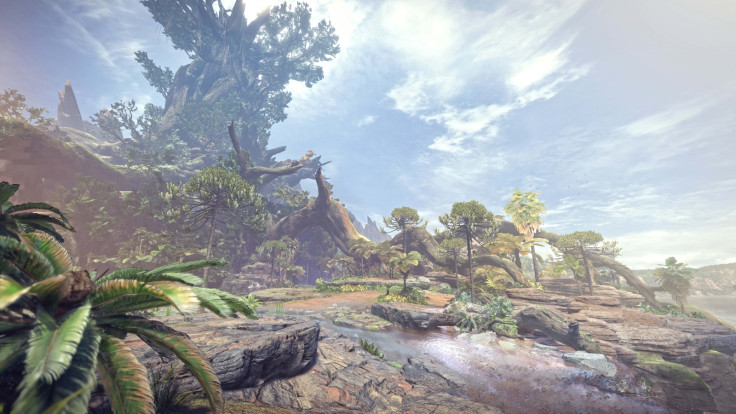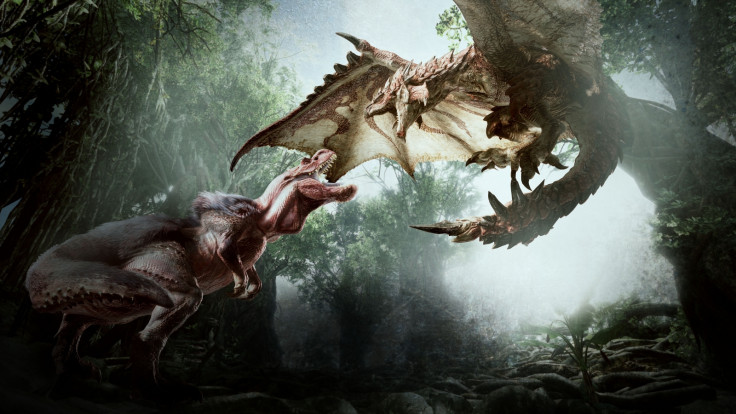Monster Hunter World: Is Capcom's evolved Jurassic Park fantasy gaming's next apex predator?
Capcom's behemoth franchise finally bore its teeth at E3 2017 - now it's on the hunt for global success.
When it comes to concepts for video games, few are as immediately compelling as the elevator pitch for Capcom's Monster Hunter series.
Set in a strange ancient world where humanity shares its lakes and hills with a slew of terrifying and gargantuan prehistoric beasts, generations of fearless warriors have kept mankind alive by slaying as many giant dinosaurs as they can. These warriors are, of course, known as Monster Hunters.
With players wielding swords bigger than most cars, after stocking up on various herbs and beans, they set out on quests to topple behemoths that are even bigger than their warriors' hefty blades.
Essentially, it's Conan The Barbarian meets Jurassic Park. Yet, while its concept is an easy one to grasp, when it comes down to the gameplay, this Japanese franchise is bafflingly inaccessible.
Featuring a learning curve almost as steep as the in-game environments players climb, Monster Hunter's plethora of hidden rules and stats turn this seemingly simple action game into a head-scratching experience.
Despite this, the series has garnered a fiercely devoted audience in Japan. Selling millions of copies across both the PSP and Nintendo 3DS, Monster Hunter's deliberately clunky controls and barely explained systems have earned it a rabid following in its home land, while mainly just befuddling players across the pond.
Recent entries, however, have done the unthinkable and actually tried to explain some of the series' basic elements. Yet, despite slowly making this daunting series more inviting, for the last decade its core confusing gameplay has remained largely unchanged.
Reinventing a monster franchise
Now, 13 years after the series' PS2 debut, it finally looks like Capcom is making some big changes in order to ensnare its most dangerous and unpredictable prey yet – a dedicated western audience.
Moving the series away from its long-lasting home on portables, this year's E3 saw Capcom reveal its first main console outing since the Nintendo Wii's Monster Hunter Tri. After taking a first look at an extended demo of Monster Hunter World, it became immediately clear that the series' twelfth mainline entry is shaping up to be its most accessible yet.
As the subtitle suggests, the sprawling game world is the star of the show. My demo begins with the camera panning over a lush and densely populated jungle showing the series' once poorly rendered flora and fauna now bustling with life. Visually this is obviously a bit of a step up from the 3DS titles, transforming the series' once blurry vistas into intricately populated HD environments. Yet, for franchise devotees, it's not the visual changes that became the biggest talking point.
Following the E3 trailer, unveiled during Sony's conference, many fans assumed that Monster Hunter World would take the franchise into an overly cinematic direction, swapping that addictive grinding and crafting loop for a more watered down, linear approach.
While there were certainly some highly scripted moments during my demo, when it comes to that core Monster Hunter gameplay loop, I'm happy to say that it looks like the franchise's beloved combat will offer the same kind of depth that fans expect.
With the demo helmed by game director Yuda Tokuda, he guides his heavily armoured Hunter cautiously into the humid-looking hunting ground. In what looks suspiciously like a helpful tutorial, he's then greeted by an almost aggressively chirpy woman, as she proceeds to relay the basics during this early-game quest.
A Jurassic world
Set in an entirely new continent, Monster Hunter World sends players out to track down a mysterious new beast known as an Anjanath – a fearsome T-Rex sized creature sporting what looks like spears for teeth and leather-like skin. This creature has been laying waste to even your village's most fearless warriors, now it's up to players to bring back his hide.
Once Tokuda's Hunter begins to head to his quest, it becomes immediately clear that the new environments shown here are not just a game changer because of the new HD sheen. In previous games, environments were largely just empty battlegrounds, occasionally populated by a few herbivores or some of the smaller monsters that roam the dangerous landscape. If you were lucky, you might even occasionally see some of the monsters try and eat each other.

In World, however, your surroundings are just as dangerous and unpredictable as the monsters you are hunting. As Tokuda guides his character through the jungle, tiny insects scuttle across the undergrowth as strange beasts stop to look at him before continuing to feast on their juicy carrion. Working his way down the path past a pack of happily grazing herbivores, a swarm of Velociraptor-esque predators slowly approach the unsuspecting herd.
Unfortunately for the raptors their meal will have to wait, because they have been spotted by some equally hungry prey. A terrifying toad-esque creature called a Great Jagras suddenly bursts out of the woods, charging the pack of confused raptors and gobbling two of them up in one fell swoop.
It's all brilliantly animated, with a raptor's squirming body visibly receding into the Jagras' gargantuan mouth, before one final gulp sees the lifeless corpse slide down into the monster's stomach. It's the first time in the franchise where Monster Hunter actually feels like the medieval Jurassic Park fantasy that it has always promised to be.
This is largely thanks to how Capcom has decided to approach the core structure of the game's world. This time, it has done away with the series staple of small interconnected areas and instead focused on creating one large, bustling open world for players to explore. As well as striking a death knell for the once constant loading screens, this new approach to world design changes the way that players hunt.
In previous games, Hunters would have to run around these boxy environments aimlessly until they stumbled upon their prey. Thankfully, this archaic system is now a thing of the past. Here, Hunters have enlisted the help of scout flies - a group of glowing insects that help players find hidden monster tracks.

Into the belly of the beast
En route to the Anjanath, the scout flies quickly detect a trail of its sickly glowing mucus, allowing us to pick up its trail while carefully avoiding the now satisfied (but still terrifying) Great Jagras. Tokuda follows the trail until it stops just outside a dimly lit cave. As he creeps inside, he soon spots his sleeping prey.
Cloaking himself in a sniper-esque leaf-coated camouflage coat, he lobs a stone at the sleeping beast, quickly throwing off his disguise and luring the enraged Anjanath toward him – and right into a trap.
As the beast lunges forward, it suddenly stops mid charge, roaring in fury. It has become completely ensnared in a tangle of vines and tree roots. Seizing his opportunity, Tokuda hacks away at the snarling beast's tail, before launching a well-aimed hookshot and soaring up into a tree top overlooking the cave.
The Anjanath, furious and humiliated, eventually frees itself and prepares to retaliate. Just as it looks like it's too late for poor old Tokuda, a gigantic draconic beast swoops in and takes a bite out of the startled Anjanath. Tokuda explains that this massive monstrosity is called a Rathlos, and we were fighting in its nest.
While the demo was undoubtedly scripted, I came away hugely impressed with the promise that its brilliantly realised world showcased. If the final product can deliver a hunting fantasy that feels half as dangerous and unpredictable as this demo hinted at, Monster Hunter World won't just be the best game in the series, it'll be one of the most atmospheric adventures the medium has ever seen.
Monster Hunter World is set for release on Xbox One and PS4 in "early 2018" followed by a PC at "a later date".
© Copyright IBTimes 2024. All rights reserved.






